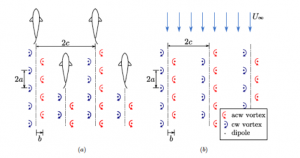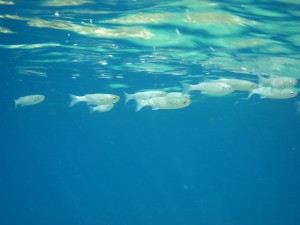Flying and swimming animals fly in pattern formations all over the world. The classic “V” shape of geese is used to help make their migration flights less taxing, while the similar layout of a school of fish helps them navigate ocean currents. Both water and wind flow in streams, which are efficiently shaped by fins and wings.
So, if nature can find a way to harness the power of air or water currents so easily, why can’t wind turbines? Vertical turbines have a lot of similarities to fins, which means they might be able to take advantage of the same patterns used by schools of fish.
The Problem: Wind Shadows
Normal turbines have to be spaced fairly far apart to be effective. A turbine slows the wind that passes through it, creating what is known as a “wind shadow.” This difference isn’t noticeable at first, but if you stack enough turbines next to each other, you’ll start to notice a distinct lack in power generation. Each turbine slows the wind a little more, until there’s almost nothing at the end of the line.
There are two ways wind farms deal with this. One option is to simply get a larger amount of land, and space out the turbines appropriately. Another option is to rent small areas from local landowners, placing turbines on unfarmable patches of land spaced so far about that wind shadows become negligible.
Inspiration from a School of Fish

Diagram of vortices caused by fish fins. Image credit GizMag
When water flows off the fins of a lead fish, it creates vortices, or pockets of moving water. The next fish uses these pockets to move forward in the water, and creates another set of pockets for the fish behind them.
John Dabri, a professor at Caltech, suggests that we can use this concept to increase the efficiency of wind turbines. Vertical axis turbines cut through the air much like a set of fins; by interspersing turbines meant to rotate in one direction or another, there’s a chance to harness these swirling pockets of wind and increase the energy efficiency of a farm even further.
Downsides and Issues
Of course, no idea is perfect. There’s a reason why you aren’t seeing Dabri’s concept in motion yet: it isn’t completly refined.
The main problem is that, in order for this “school of fish” layout to work, the wind has to be blowing from a set direction. The moment it shifts, the perfect alignment is thrown out of whack. Depending on the angle, this can decrease energy by a small amount, or take the benefits away entirely.
The second problem is that the space around turbines isn’t just dead. Farm crops, grass space, and service roads take up the ground around the base of a turbine, while the turbine itself takes up the air. GizMag mentions that the school of fish layout would render the surrounding area completely useless – or at least, far more useless than it is now.
So is it Viable?
Dabri’s method isn’t new – he first unveiled the concept in 2010, and it’s been looked at before. In ideal conditions, it could work incredibly well, but it still needs fine tuning to hold up in real life.
In the meantime, the question is whether we need to look into condensing large wind farms, or spreading the turbines out over a rural area. Many people feel that the existence of turbines ruins the view or the landscape, and causes noise pollution. Condensing the turbines to a single farm increases the noise pollution in one area, but keeps it out of other spaces; spreading them out lowers the overall pollution but increases the span of the affected area. Before we look into ways to make wind energy more efficient, we need to decide which option is more viable.


Comments are closed